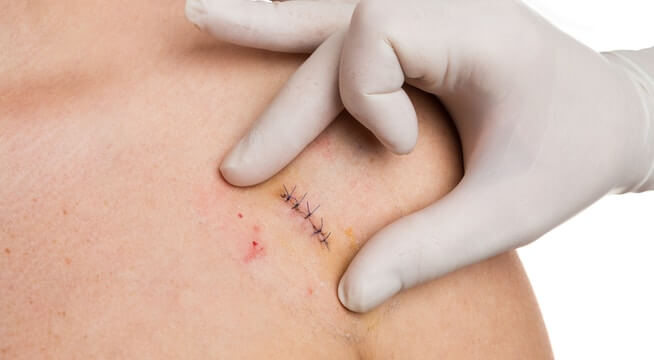
Stitches, or sutures, are a common treatment for minor lacerations that can’t heal on their own or for incisions from surgical procedures. The procedure of closing a cut or incision is very safe, but after the stitches are in place, many people have questions about how to best take care of their stitches so they avoid complications such as infections, scarring or slow healing.
4 Tips for Taking Care of Stitches
If you or your child have recently had stitches put in place, here are some tips for keeping the stitches clean, healthy and as pain-free as possible.
1. Keep the Wound Clean
Most doctors recommend keeping your wound dry for 24 hours after the procedure to minimize the chance of infection. After 24 hours post op, use gentle dabs with a moist rag to keep the wound clean, removing dirt, debris and any leaking fluids. Depending on the size of the wound, it may be wise to place a bandage over it to keep it clean. For children, they should refrain from playing in sand, dirt or mud until the stitches are removed.
2. Avoid Excessive Water
You will need to use water to clean the wound, but submerging the wound or exposing it to excessive moisture can negatively impact the stitches’ integrity. Avoid swimming and baths completely until the stitches are removed. You can take showers, but don’t allow the wound to be sprayed head-on and don’t stay in the shower for too long. Gently pat the wound dry if it does get wet.
3. Resist the Urge to Scratch
Stitches can be itchy, but it’s important to resist the urge to scratch them. Worst case scenario is the stitches could be pulled out or ripped. A lot of scratching can also increase the chance for infection if the fingers and hands are dirty. Children are especially tempted to scratch the wound, so parents may want to cover the wound with gauze and antibiotic ointment to try and keep their fingers away.
4. Keep Your Movements Limited
Excessive movements near the wound can potentially rip the stitches and re-open the wound, so it’s best to avoid putting pressure on or near the wound when possible. Most adults won’t have many issues here. Unfortunately, in the exuberance of playing, children with stitches have a tendency to forget or choose to ignore the risk. Not all movements will be off limits, but just make sure kids understand that placing stress on the tender area should be limited. Contact sports should be avoided until the stitches are removed.
Symptoms to Monitor
If you follow your doctor’s instructions after the stitches are applied and keep up with these tips, you are much less likely to experience any complications or infection. But just in case, you should become familiar with signs of infection so you know when to seek additional treatment.
Increasing Pain: Soreness after the procedure is common, but stitches should be relatively pain free afterward.
Progressive Redness: Watch for redness that spreads away from the wound.
Swelling: Some swelling after the procedure is also common, but it should go away.
Pus: Fluids leaking from the wound are expected, but excessive pus is a sign of infection.
Foul Odor: The wound shouldn’t smell. If it does it’s vital to seek medical attention immediately.
Fever: Always keep an eye out for fever, as it can indicate infection.
Receiving Treatment in Colorado Springs, Colorado and Texas
Some stitches, like those used inside the mouth, dissolve on their own, but in most cases, you will need to return to a doctor to have your stitches removed. If you notice any symptoms of infection, don’t hesitate to visit a professional medical clinic as soon as you can.
Complete Care provides adult and pediatric urgent care and emergency room services in Colorado Springs and Texas. Our professionals commonly stitch up minor lacerations and remove stitches for patients who may have received them elsewhere. Whether your needs are related to stitches or any number of medical needs or emergencies, our health care professionals provide exceptional care without the lengthy wait times found at hospitals. Visit Complete Care online today for more information!
